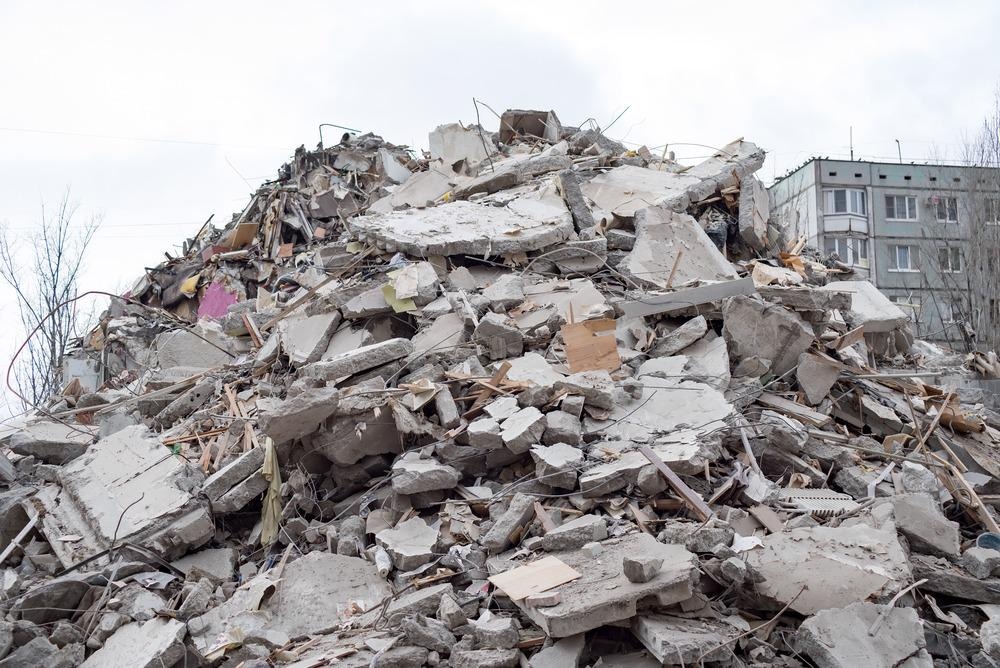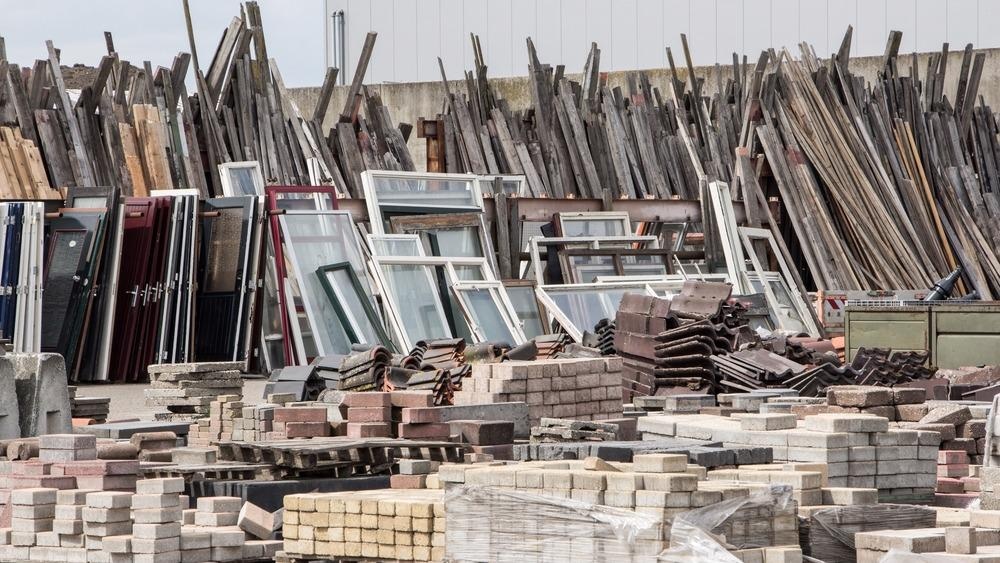Most non-recyclable materials are hazardous, which means that they contain particles or substances that are destructive or harmful to the environment or human beings. Examples of hazardous waste materials are stripping paint, asbestos, aerosol cans, lead, polychlorinated biphenyls (PCB), solvents, contaminated soil, non-inert material, and insulation materials.

Image Credit: Sytilin Pavel/Shutterstock.com
From 2014 to 2020 there has been a reduction in hazardous waste produced in the construction industry, from 4.8 to 4.3 million tons.
The Construction Industry: Waste Production
Any materials with no residual value created by industries or humans are classified as waste. Waste that is produced in the construction industry is significantly unavoidable. In 2018, around 62% of waste was generated from demolition, construction, and excavation industries in the United Kingdom. This is around 100 million tons, as the construction industry uses around 400 million tons of materials per year.
The construction industry utilizes large quantities of raw material and, in turn, produces significant amounts of waste. The method of utilizing raw material has numerous impacts on the environment occurring during extraction and processing stages.
In the year 2020, the rate of recovery and recycling of construction and demolition waste was at 70%. A huge amount of construction waste is still being dumped in landfills. In the UK, 32% of waste comes from demolition and construction, and around 13% of that waste could be recovered and used.
Barriers Preventing the Industry from Becoming Fully Circular
Analysis by the European Environmental Agency has found several barriers affecting waste policy objectives from being achieved. There has also been a failure to change the construction industry’s mindset in adopting a circular economy way of thinking.
One of the main barriers attributed to the issue is cost. Of course, stakeholders and businesses are always looking for the most inexpensive option and there are, unfortunately, more costs associated with recycled waste.
In many cases, the processing costs are what cause secondary materials to become more expensive. For the material to be used, it must be segregated from other materials, treated in case of contamination, and any hazardous content must be removed. For these reasons, there has to be extensive time and funding to go into the progression of more effective processes to reduce this expense.
Further Reading: Recycling End-of-Life Building Glass
Along with the mindset of stakeholders needing to change, the availability of quality material and reliable data needs improvement. Many construction sites are reluctant to use secondary materials, as raw materials come with warranties and knowledge of their expected performance. On the other hand, when secondary materials are used their performance cannot always be predicted or traced.
The EEA suggests that the standardization of secondary materials will encourage the development of a circular economy.
Additionally, placing green taxes on materials creates a competitively priced market.
Non-Recyclable Hazardous Waste in the Construction Industry
Hazardous waste will always be present on building sites, and when detected could change development plans. Unfortunately, this results in costing the company both time and money.
The use of a detailed SWMP (site waste management supplier) system is the best practice and can assist in the reduction of waste on-site by 15%, further resulting in a 43% reduction of waste heading to landfills. The system will be able to advise the best practices to segregate waste and the best way to safely dispose of any hazardous materials.
The majority of hazardous waste materials are treated then disposed of in landfills. Often they are also incinerated. The inappropriate or improper storage of hazardous materials can result in fires, leaks, spills, and may contaminate drinking water or soil.

Reusable building waste. Image Credit: INTREEGUE Photography/Shutterstock.com
The environmental cleanup companies are mostly in charge of the proper disposal of hazardous materials. Most hazardous material disposal is heavily regulated under strict laws. Failure to follow these regulations can result in the exposure of toxins to the environment and hefty punishments and fines.
Reducing Hazardous Waste from Construction Sites
Preventing hazardous content in materials will ensure less exposure to our environments, and construction materials can be more easily recycled. Some hazardous content in materials has been phased out from being used in construction. For example, the removal of PCBs in joints, seals, and thermal insulated windows.
Many European frameworks and regulations focus on the prevention of using hazardous materials, specify ways to segregate hazardous waste and reduce construction waste overall.
The environmental building certification and assessment schemes focus on reducing the environmental impact through the operation, production, and construction of a building. There are parts of the scheme that focus on reducing waste production and ensuring that all materials used can either be recycled or reused.
Co-Processing Finds Uses for Non-Recyclable Waste
Co-processing is a term established in the cement industry and is the thermal process combining both recycled materials and energy recovered from waste to fuel a cement kiln. The cement kiln has been able to use solid waste, used tires, sewage sludge, waste oils, and construction and demolition waste as fuel. This process reduces the need for mineral resources and fossil fuels.
During the process of fueling the cement kiln, the mineral elements of the material used forms part of the cement clinker. Therefore, as the organic component of the waste is used for fuel there is no leftover product from the co-processing procedure including ash.
Currently, in the European Union, already over 40% of the cement industry is using waste to fuel the clinker-making process. The company Geocycle is the industry leader in the co-processing technique and has over 180 cement plants utilizing this method across Europe.
There are several examples of plants now substituting 95% of fossil fuels with waste.
Reference and Further Research
pbctoday.com. 2019. Dealing with hazardous waste in construction. [online] Available at: <https://www.pbctoday.co.uk/news/planning-construction-news/hazardous-waste-construction/53765/>
Napier, T., 2016. Construction Waste Management | WBDG - Whole Building Design Guide. [online] Wbdg.org. Available at: <https://www.wbdg.org/resources/construction-waste-management>
European Environmental Agency, 2021. Construction and demolition waste: challenges and opportunities in a circular economy. Available at: https://www.eea.europa.eu/publications/construction-and-demolition-waste-challenges/construction-and-demolition-waste-challenges
Finding sustainable uses for non-recyclable waste - CEMBUREAU (2018). Available at: http://useofcement.cembureau.eu/2018/12/03/finding-sustainable-uses-for-non-recyclable-waste/
Bakas, L., Bøe, E., Kirkeby, J. and Jørgensen Kjær, B., 2011. Assessment of initiatives to prevent waste from building and construction sectors. Copenhagen: Nordic Council of Ministers.
Sharman, J. et al. (2021) Construction waste and materials efficiency, NBS. Available at: https://www.thenbs.com/knowledge/construction-waste-and-materials-efficiency
Disclaimer: The views expressed here are those of the author expressed in their private capacity and do not necessarily represent the views of AZoM.com Limited T/A AZoNetwork the owner and operator of this website. This disclaimer forms part of the Terms and conditions of use of this website.